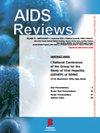Efficacy and Safety of Triple versus Dolutegravir-based Dual Therapy in Patients with HIV-1 Infection: A Meta-analysis of Randomized Controlled Trials.
IF 2.5
4区 医学
Q4 IMMUNOLOGY
引用次数: 1
Abstract
A new strategy of simplification therapy shown the unique benefits in clinical treatment, by reducing pill burden and avoid drug exposure. To provide more evidence for the strategy, we compared the efficacy and safety of dolutegravir (DTG)-containing simplified dual combination antiretroviral therapy (cART) and traditional triple cART for people living with HIV/AIDS. The meta-analysis of randomized controlled trials compared DTG-containing dual therapy with triple cART. The primary outcome was virologic suppression. The secondary outcomes included CD4T cell recovery, lipids change from baseline, and adverse events (AEs). A total of 7 studies, 4852 patients were eligible, 2423 (49.9%) received DTG-based simplified dual cART, and 2429 (50.1%) received triple cART. The viral suppression rate was 94.7% at 24 weeks, 93.0% at 48 weeks, and 96.6% at 96 weeks in dual cART. The viral suppression rate of dual cART was non-inferior to triple cART at 24 weeks (risk difference [RD], -0.00; 95% confidence interval [CI] -0.02-0.01), at 48 weeks (RD, -0.01; 95% CI -0.02-0.01), and at 96 weeks (RD, -0.01; 95% CI -0.02-0.00). Sub-analysis results were consistent with the overall results. With regard to other outcomes (CD4T counts, lipids, any AEs, and AEs grade ≥ 3), there was no significant statistical difference between the two regimens. DTG-based simplified dual cART was non-inferior to triple cART in terms of efficacy and safety. This finding provides strong support for current consensus guidelines recommended the dual regimen as first-line treatment.HIV-1感染患者三联治疗与多曲地韦双重治疗的疗效和安全性:随机对照试验的荟萃分析
一种新的简化治疗策略通过减少药丸负担和避免药物暴露,在临床治疗中显示出独特的益处。为了为该策略提供更多的证据,我们比较了含多替格拉韦(DTG)的简化双联合抗逆转录病毒治疗(cART)和传统三联抗逆转录病毒治疗(cART)对HIV/AIDS感染者的疗效和安全性。随机对照试验的荟萃分析比较了含dtg的双重治疗与三联cART。主要结果是病毒学抑制。次要结局包括CD4T细胞恢复、脂质从基线变化和不良事件(ae)。共有7项研究,4852例患者入选,2423例(49.9%)接受基于dtg的简化双重cART, 2429例(50.1%)接受三重cART。双cART治疗24周时病毒抑制率为94.7%,48周时为93.0%,96周时为96.6%。在24周时,双重cART的病毒抑制率不低于三重cART(风险差[RD], -0.00;95%可信区间[CI] -0.02-0.01), 48周时(RD, -0.01;95% CI -0.02-0.01), 96周时(RD, -0.01;95% ci -0.02-0.00)。亚分析结果与总体结果一致。至于其他结果(CD4T计数、血脂、不良事件、不良事件等级≥3),两种方案之间没有显著的统计学差异。基于dtg的简化双cART在疗效和安全性方面不逊色于三重cART。这一发现为目前的共识指南推荐双方案作为一线治疗提供了强有力的支持。
本文章由计算机程序翻译,如有差异,请以英文原文为准。
求助全文
约1分钟内获得全文
求助全文
来源期刊

AIDS reviews
医学-传染病学
CiteScore
3.40
自引率
4.50%
发文量
41
审稿时长
>12 weeks
期刊介绍:
AIDS Reviews publishes papers reporting original scientific, clinical, epidemiologic and social research which contribute to the overall knowledge of the field of the acquired immunodeficiency syndrome and human retrovirology. Currently, the Journal publishes review articles (usually by invitation, but spontaneous submitted articles will also be considered). Manuscripts submitted to AIDS Reviews will be accepted on the understanding that the authors have not submitted the paper to another journal or published the material elsewhere.
 求助内容:
求助内容: 应助结果提醒方式:
应助结果提醒方式:


